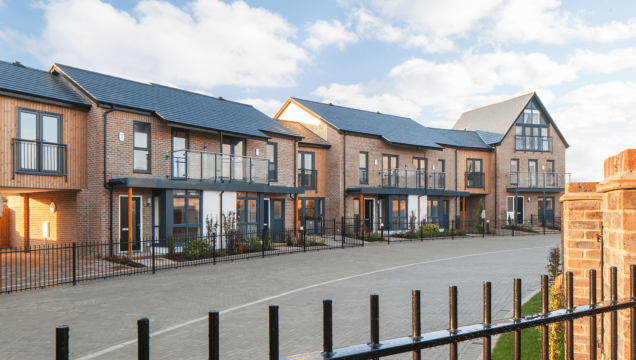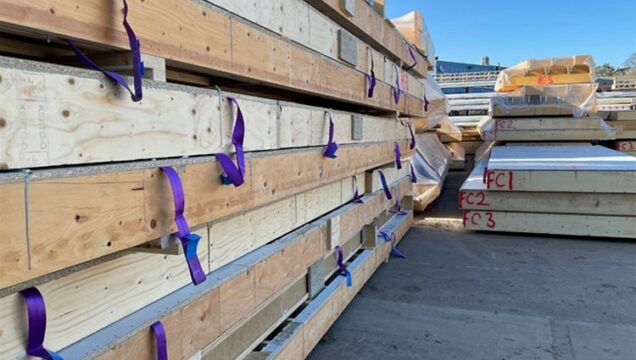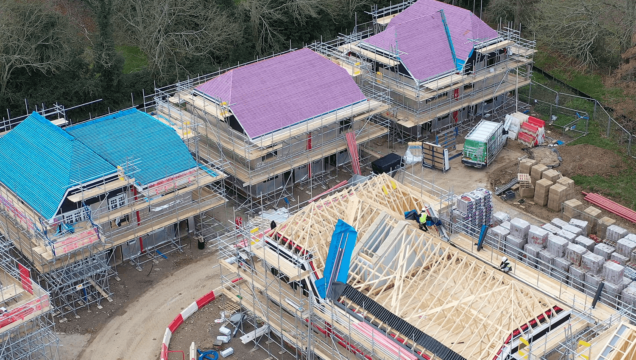

As with all forms of construction, fire safety is an important consideration when using timber frame construction. Through from the design and manufacture stage to the management and build phase, fire is always a key consideration, so it’s important to have precautions in place.
This is where the 16 steps come in. Following on from our “Are Timber Frames a Fire Risk?” article, we wanted to delve deeper into the 16 Steps to Fire Safety on Timber Frame Construction Sites.
The Structural Timber Association (STA) launched the 16 steps to help protect timber frame sites and reduce the risk of fire. It’s become essential for key decision-making processes during development projects and is regularly used by Health & Safety Executives (HSE) in site inspections.
//Do the 16 Steps to Fire Safety Apply to Projects of Any Sizes?
Yes, they do. Every project and development require a 16 step assessment with this adapting slightly to ones of a larger or smaller size. So, developments with over 600m2 cumulative floor area requires a more in depth assessment. Whereas developments below this will still need a fire risk assessment in proportion to the risks posed by the location.
//What Are the 16 Steps to Fire Safety on Timber Frame Construction Sites?
You can find all the steps here, but we’ve condensed it down in an easy-to-read way below.
The 16 steps are categorised by 3 different phases of timber frame construction:
- Steps 1 – 3 are for the Design & Tender Phase
- Steps 4 – 7 are for the Pre-Site Start of the Construction Phase
- Steps 8 – 16 are for During the Construction Phase
Design & Tender Phase
Step 1 – Legal & Insurance Requirements
The Principal Designer must consider the fire spread outside the boundary. If any risks are noted, this must be communicated to the Principal Contractor in the tender document.
Actions to be taken:
- Design Team must undertake an off-site Fire Risk Assessment; either a preliminary review based on STA guidance or project-specific review by a Fire Engineering approach.
- If this assessment will be extended or finalised by the Principal Contractor, this requirement must be clearly referenced.
Step 2 – Designing Out Fire Risk
The Principal Designer must consider the fire risk during the build process under the 29 Construction (Design and Management) Regulations (CDM) 2015. The choice of layout, materials or approach must be considered regarding risk of fire spread, endangering persons on the site or outside the site boundary.
Actions to be taken:
- Off-site risk assessment to be taken and followed
- Remove any project design elements that pose fire risks or note them as a risk for the Contractor to manage. Examples of risks include:
- No hot works (Operations that require the local application of heat)
- Timber frame (Increased construction phase risk management)
Step 3 – Consideration of Fire Risk During Construction
The Principal Designer must include fire protection as part of the design and build process.
Actions to be taken:
- After taking into account the findings from the 2 previous steps, provide drawing and tender information on compartmentation.
- For large sites, consider fire safety elements, such as fire extinguisher placement, and provide information for the Principal Contractor.
Construction Phase – Pre-Site Start
Step 4 – Legal Requirements
Site management are to be aware of their legal duties on the management of fire risks and be familiar with fire safety legislation:
- In England and Wales, it is the Regulatory Reform (Fire Safety) Order 2005 (RRO)
- In Scotland, it is the Fire (Scotland) Act 2005 (FSA)
- In Northern Ireland, it is the Fire Safety Regulations (Northern Ireland) 2010 (FSR)
Actions to be taken:
- Undertake an on-site fire risk assessment
- Appoint a fire safety coordinator
- Establish a fire safety plan
Step 5 – Fire Safety Coordinator
A responsible person needs to take ownership of the management of the risk assessment process.
Actions to be taken:
- Appoint a responsible person to coordinate fire safety both pre-site start and during construction.
Step 6 – The Site Fire Safety Plan
After the risk assessments, a site fire safety plan should be made to minimise the risk of fire, to protect the people working on the site, and to consider the risk of fire spread outside the site boundary.
Actions to be taken:
- Write a fire safety plan and continually review it as construction progresses
Step 7 – Communication & Liaison
Regular communication and liaison with other parties, such as the emergency services and security, is essential in helping to assess and manage the potential fire risks during construction.
Actions to be taken:
- Regular communication and liaison with other parties
Construction Phase – During Construction
Step 8 – Promoting a ‘Fire Safe’ Working Environment
Fire safety processes and precautions for the site are to be fully maintained throughout the entire construction period.
Actions to be taken:
- Security measures put in place around the site
- Provide all workers with fire safe guidance during construction
- Conduct fire drills as appropriate for the site
- Provide portable fire extinguisher and safe smoking locations
Step 9 – Fire Detection & Warning
Fire detection and warning features must be put into place. This includes installed alarms that alert early detection of a fire, installed portable fire extinguishers, established routines for evacuation, and allocated responsibilities to call the emergency services.
Actions to be taken:
- Install appropriate quality tested fire alarms at fire point stations
- Install proportionate fire warning elements (e.g., heat detectors, CCTV, thermal image cameras)
- Make neighbours aware of alarm type
Step 10 – Emergency Escape Routes
Clear, unobstructed emergency exit routes should be maintained for workers in all areas of the site at all times, so site evacuation procedures can be initiated if necessary.
Actions to be taken:
- Provide a minimum of 2 escape routes that are clearly marked and accessible
- Make sure escape routes are included in the fire safety plan
- Put up notices around the site signifying escape routes
- Continually review escape routes during the changing construction works and update as necessary
Step 11 – Site Security
All sites should be enclosed and made secure out of working hours against unauthorised entry. Also, it’s recommended to look into the history of deliberate fire setting, incidence of vandalism or other ASB in the area before designing site security.
Actions to be taken:
- All sites should be enclosed with a security fence and gated entrance
- All sites should be made secure with appropriate security measures put in place (e.g., CCTV, watchmen, etc.)
Step 12 – Fire Safe Site Facilities
Site facilities includes workers and management temporary buildings, storage of materials (including flammable liquids and LPG), on-site smoking areas and catering facilities. All of these facilities must have appropriate fire safety measures put in place.
Actions to be taken:
- Have appropriate fire rated storage of construction materials
- Have appropriately fire rated temporary buildings for site workforce
- Fire detection is to be provided for temporary buildings within 20m of a new building
- Clear signposted and communicated muster points noted in the fire plan
- Appropriate firefighting provision proportionate to the scale of the project
Step 13 – Plant, Equipment & Vehicles
Risk assessments are required on all plant, equipment and vehicles that can be a fire hazard. Combustible fuel can present a fire risk, so vehicles and equipment must be assessed.
Actions to be taken:
- Avoid equipment which requires flammable fuels
- Electrical plants are to have checks on charging points
- Work permits are required for recharging equipment
- Plants that have combustible fuel are to be isolated in the open air, away from the site boundary and new buildings
- Vehicles should not be parked within 10 metres of the new build unless a work permit is provided
Step 14 – Site Organisation & Tidiness
Site rubbish and material off cuts present a fire hazard, so they must be disposed of correctly.
Actions to be taken:
- Combustible waste materials are to be collected and stored in fire resistant bins
- Regular checks on site to avoid waste becoming a fire hazard should be undertaken
- No rooms shall be used as waste storage
- Wood waste/cuttings are to be bagged and collected daily
- Under no circumstances should there be any site bonfires
Step 15 – Checks, Inspections & Tests Throughout Construction Phase
A responsible person should be appointed to co-ordinate site fire safety, establish and review throughout the build programme the fire safety plan.
Actions to be taken:
- Fire risk assessment should be regularly reviewed, especially when:
- A significant change occurs in the matters taken into account when the fire risk assessment was carried out
- At the commencement of each construction phase
- A significant change occurs on the site
- Confirm whether work recommended in the original risk assessment has been carried out correctly
- Daily, weekly and monthly checks must be carried out
- Roles and responsibilities must be clearly identified
Step 16 – Permits to Work
Where proposed works or methods may cause of fire or create a weakness in fire robustness, work permits are recommended.
Examples of permits to work are:
- Hot works/welding
- Vehicles within 10m of new build
- Security changes
- Alarm changes
- Fire stopping changes
- Fire door changes
- Site facilities
- Plant and equipment
- Waste storage changes
- Scaffold changes
- Escape route changes
- Heating/dryers not to be used
//Get Your Questions Answered
These 16 steps to fire safety on timber frame construction sites cover all sizes of developments and help with assessing both on- and off-site fire risks. Following these steps for every project helps to manage health and safety, so every member involved is protected as well as the structure.
At Pinewood Structures, we always enforce the STA’s 16 step policies as part of our “Site Safe” responsibilities. We are happy to answer any questions you may have, with over 40 years helping our customers, we are Trusted to Deliver.
Call us on 01767 651218 or fill out our contact form if you have any questions or queries.


